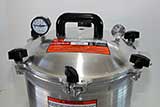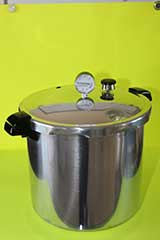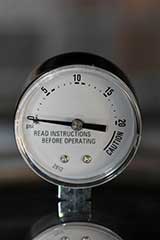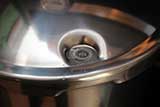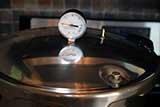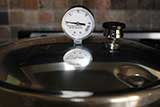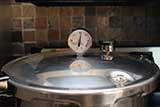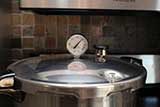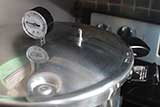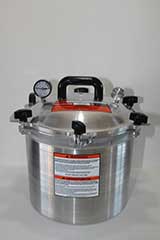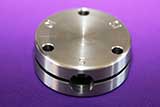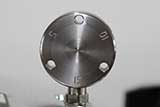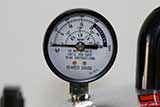Meats and Sausages
Pressure Canners
Low-acid foods must be processed in a pressure canner to be free of botulism risks.
To destroy microorganisms in low-acid foods processed with a pressure canner, you must process the jars using the correct time and pressure specified for your altitude. The food may spoil if you fail to select the proper process times for specific altitudes, fail to exhaust canners properly, process at lower pressure than specified, process for fewer minutes than specified, or cool the canner with water. Small pressure canners hold four-quart jars; some large pressure canners hold 18 pint jars in two layers, but hold only seven quart jars. Pressure saucepans with smaller volume capacities are not recommended for use in canning. Small capacity pressure canners are treated in a similar manner as standard larger canners, and should be vented using the venting procedures. Modern pressure canners are lightweight, thin walled kettles; most have turn-on lids. They have a jar rack, gasket, dial or weighted gauge, an automatic vent/cover lock, a vent port (steam vent) to be closed with a counterweight or weighted gauge, and a safety fuse. Pressure does not destroy microorganisms, but high temperatures applied for an adequate period of time do. A pressure canner is separated from the outside air by a forcefully shut lid.
The success of destroying all microorganisms capable of growing in canned food is based on the temperature obtained in pure steam, free of air, at sea level. At sea level a canner set to a gauge pressure of 10-1/2 lbs provides an internal temperature of 240° F (116° C).
It is the amount of heat applied to the unit that regulates pressure.
If heat is continuously applied and the steam is prevented from escaping, the increasing pressure will reach the point when the vessel will explode. To prevent that a pressure canner employs an adjustable pressure regulator, and of course, a safety valve (overpressure plug) which will open when the pressure reaches a dangerous level. As the pressure is changing within the unit, the pressure regulator weight jiggles and sputters which is simply a process of constantly building up and releasing pressure to maintain the setting on the pressure regulator weight. Allow the canner to cool at room temperature until it is completely depressurized. Pressure canners use two types of pressure gauges:
- Weighted gauge
- Dial gauge
It should be noted that a dial gauge needs to be checked for accuracy every year. Some canners come with a rubber sealing gasket and others make a tight fit without employing gaskets at all. All pressure canners come with detailed instructions for their use. Weighted gauge has three settings: 5 PSI, 10 PSI and 15 PSI.
| Pounds of Pressure (PSI) | Temperature | |
|---|---|---|
| ° C | ° F | |
| 1 | 100 | 212 |
| 5 | 108 | 227 |
| 10 | 116 | 240 |
| 15 | 121 | 250 |
Two layers of jars can be processed at once, as long as the pressure canner is tall enough. Place a small wire rack between the layers to facilitate the circulation of steam. Make sure that there is 2-3" of water in the bottom.
Presto Pressure Canners
National Presto Industries has been making Presto Pressure Canners for over 50 years. Presto Pressure Canners are made of high quality aluminum for great heat distribution. Don't confuse the pressure canner with smaller pressure cookers, also made by PrestoÆ.
PrestoÆ pressure canners operate on a dial gauge principle. The dial gauge does not regulate the amount of pressure, it is just an indicator of the pressure inside. The pressure is controlled by increasing or decreasing heat supply. What is called the pressure regulator is actually a safety device to prevent pressure in excess of 15 pounds to build in the canner. The regulator sits loosely on top of the vent pipe, right to the dial gauge in the above photo. The real safety valve known as the overpressure plug is made of black rubber and can be seen on the left behind the dial gauge. Once the pressure increases to 15 PSI the pressure regulator starts to rock releasing pressure and maintain the setting at 15 PSI. If for any reasons the vent pipe becomes clogged, the regulator will not sense it so the pressure will increase well over 15 PSI. However, the overpressure plug will pop out releasing the pressure. Check the vent pipe every time when the cover is placed on.
There is a clever device called an air vent which is basically a cover lock. When the pressure start to build up, the air vent pops out and automatically exhausts air from the canner. At the same time it engages with the bracket on the inside of the canner preventing the cover from being opened when there is pressure in the canner. It acts as a visual indication of pressure in the canner.
The heat is on, the air from the canner escapes through the vent pipe, which is not covered with a pressure regulator yet. Once the air exhausts out, the pressure regulator will be placed on top of the vent pipe where it will sit loosely. There is no indication of the dial yet, but the raising pressure and escaping air have already pushed the air vent up.
When the end of the processing time is reached, the heat is turned off. The canner should be removed from the electrical burner to prevent unnecessary heating, however, lift it carefully up, otherwise you may scratch a surface of the glass top stove. If you are using a gas burner, just turn off the heat. The canner must cool by itself until the dial reads 0 psi and the air vent drops down. Now, the pressure regulator can be taken off the vent pipe and the cover can be removed.
WARNING escaping steam can scald you and the pressure control may be hot. Protect your hands with oven gloves and tilt the cover so steam escapes away from you. Using a jar lifter remove the jars one at a time. Place the hot jars on dry towels or a cooling rack. Let them sit undisturbed for 12 hours. Remove the screwbands and test the jars.
All American Pressure Canners
Established in 1909, Wisconsin Aluminum Foundry makes top quality pressure canners and can sealers. It is a heavy duty canner, without a rubber seal, operating on the weighted gauge principle.
When the pressure canner reaches the proper temperature, the regulator weight will jiggle audibly and some steam will be released. The pressure will be automatically maintained for proper pressure cooking.
Mirro Pressure Canners
Mirro pressure canners work on a weighted gauge principle. There is no dial pressure indicator. Use canners that are equipped with weighted gauge (5, 19, 15 lb) only. Do not try to can in single-control model. The weighted gauge should jiggle about 2-3 times per minute. All pressure canners come with a rack. Placing jars directly on the bottom of the canner will likely crack them. Keep the jar upright at all times. Tilting the jar could cause food to spill into the sealing gasket of the lid and produce an imperfect seal. The jars may be stacked in the canner on two levels. Place another rack on top of the first row, then add more jars on top or offset the jars by placing one across two others.
Storage of the Canner
Clean and dry your canner. Store it with crumpled newspapers or paper towels in the bottom and around the rack. Place the lid upside down on the canner to protect the gauge, vent and sealing ring. Storing cans at high temperatures may result in flat sour - a type of spoilage where the can ends remain flat but the food turns sour. It is caused by heat loving bacteria which grow at 150-160° F, 66-71° C. Inadequate cooling after canning or storage at high temperatures promotes such spoilage.

